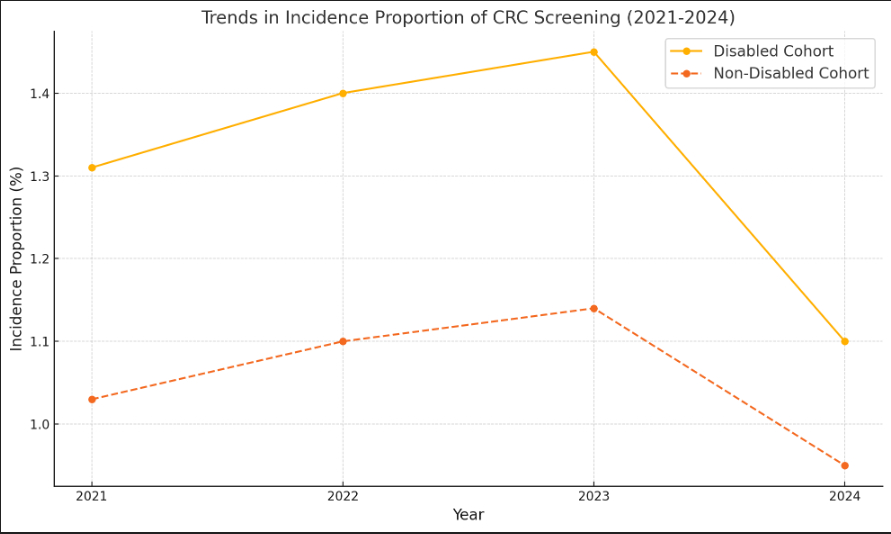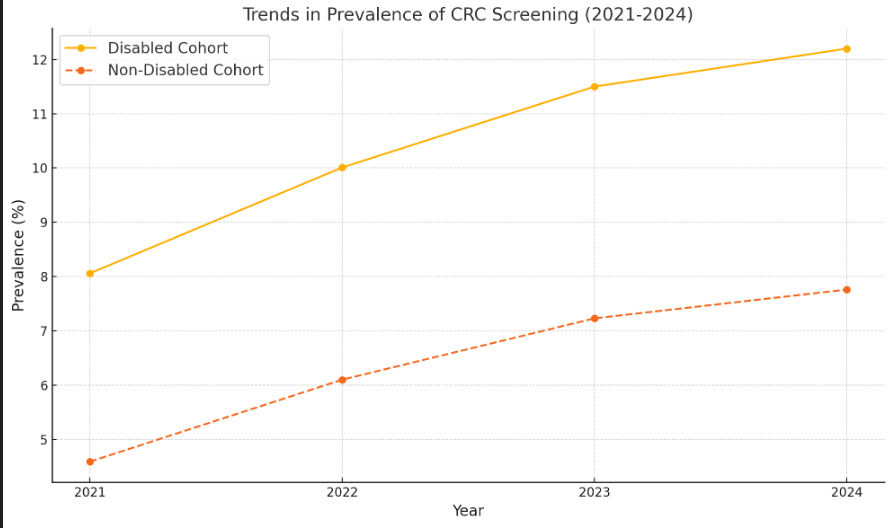Monday Poster Session
Category: Colorectal Cancer Prevention
P2609 - Disparities in Colorectal Cancer Screening Trends Among Patients With and Without Disabilities
Monday, October 27, 2025
10:30 AM - 4:00 PM PDT
Location: Exhibit Hall

Amer Arman, MD
MedStar Health
Detroit, MI
Presenting Author(s)
Amer Arman, MD1, Omar Arman, MD, MPH2, Omar Daas, MD3, Mohammed Damdoum, MD4, Hebah Jaber, MD5, Khaled Rafeh, MD6, Mazen Zamzam, BS7, Jad Bou-Abdallah, MD2
1MedStar Health, Washington, WA; 2University at Buffalo, Buffalo, NY; 3University of Jordan School of Medicine, Amman, 'Amman, Jordan; 4Windsor University School of Medicine, Cayon, Saint Paul Charlestown, Saint Kitts and Nevis; 5Mutah University, Mutah, Al Karak, Jordan; 6School of Medicine, The University of Jordan, Shmeisani, 'Amman, Jordan; 7Oakland University William Beaumont School of Medicine, Royal Oak, MI
Introduction: Colorectal cancer (CRC) screening is a crucial preventive measure, yet disparities persist among disabled populations. This study evaluates trends in CRC screening incidence, prevalence, and incidence rates between disabled and non-disabled cohorts from 2021 to 2024.
Methods: We conducted a retrospective analysis using TriNetX data for patients aged 45–75. We identified two cohorts: disabled (n=722,574; defined using ICD-10 codes) and non-disabled (n=19,317,514). We measured CRC screening using CPT codes for colonoscopy, sigmoidoscopy, and fecal occult blood tests. We compared trends in incidence proportions, prevalence, and incidence rates annually.
Results: CRC screening incidence proportions increased in both cohorts until 2023 but declined in 2024. The disabled cohort experienced a sharper drop (0.0145 to 0.0110) compared to the non-disabled cohort (0.0103 to 0.0095) (Figure 1). Prevalence steadily increased across the study period, with higher rates in the disabled cohort (0.1220 in 2024 vs. 0.0776 in the non-disabled cohort) (Figure 2). Incidence rates remained higher in the disabled cohort across all years, with a slight but persistent difference compared to the non-disabled cohort.
Discussion: The steady increase in CRC screening prevalence highlights its cumulative nature; however, the 2024 decline in incidence proportion, particularly among disabled patients, suggests barriers to healthcare access, saturation among previously screened individuals, or incomplete data collection. Logistical challenges, limited mobility, and systemic inequities within healthcare systems may further contribute to these disparities, highlighting the need for tailored public health interventions that address the unique barriers faced by disabled populations. While overall CRC screening prevalence continues to rise, the decline in new screenings in 2024, particularly among disabled populations, emphasizes the importance of improving outreach, expanding equitable healthcare access, and implementing disability-focused policies within CRC screening programs to address disparities and promote equity in CRC prevention.

Figure: Figure 1: The incidence proportion of CRC screening from 2021 to 2024.

Figure: Figure 2: The prevalence of CRC screening from 2021 to 2024.
Disclosures:
Amer Arman indicated no relevant financial relationships.
Omar Arman indicated no relevant financial relationships.
Omar Daas indicated no relevant financial relationships.
Mohammed Damdoum indicated no relevant financial relationships.
Hebah Jaber indicated no relevant financial relationships.
Khaled Rafeh indicated no relevant financial relationships.
Mazen Zamzam indicated no relevant financial relationships.
Jad Bou-Abdallah indicated no relevant financial relationships.
Amer Arman, MD1, Omar Arman, MD, MPH2, Omar Daas, MD3, Mohammed Damdoum, MD4, Hebah Jaber, MD5, Khaled Rafeh, MD6, Mazen Zamzam, BS7, Jad Bou-Abdallah, MD2. P2609 - Disparities in Colorectal Cancer Screening Trends Among Patients With and Without Disabilities, ACG 2025 Annual Scientific Meeting Abstracts. Phoenix, AZ: American College of Gastroenterology.
1MedStar Health, Washington, WA; 2University at Buffalo, Buffalo, NY; 3University of Jordan School of Medicine, Amman, 'Amman, Jordan; 4Windsor University School of Medicine, Cayon, Saint Paul Charlestown, Saint Kitts and Nevis; 5Mutah University, Mutah, Al Karak, Jordan; 6School of Medicine, The University of Jordan, Shmeisani, 'Amman, Jordan; 7Oakland University William Beaumont School of Medicine, Royal Oak, MI
Introduction: Colorectal cancer (CRC) screening is a crucial preventive measure, yet disparities persist among disabled populations. This study evaluates trends in CRC screening incidence, prevalence, and incidence rates between disabled and non-disabled cohorts from 2021 to 2024.
Methods: We conducted a retrospective analysis using TriNetX data for patients aged 45–75. We identified two cohorts: disabled (n=722,574; defined using ICD-10 codes) and non-disabled (n=19,317,514). We measured CRC screening using CPT codes for colonoscopy, sigmoidoscopy, and fecal occult blood tests. We compared trends in incidence proportions, prevalence, and incidence rates annually.
Results: CRC screening incidence proportions increased in both cohorts until 2023 but declined in 2024. The disabled cohort experienced a sharper drop (0.0145 to 0.0110) compared to the non-disabled cohort (0.0103 to 0.0095) (Figure 1). Prevalence steadily increased across the study period, with higher rates in the disabled cohort (0.1220 in 2024 vs. 0.0776 in the non-disabled cohort) (Figure 2). Incidence rates remained higher in the disabled cohort across all years, with a slight but persistent difference compared to the non-disabled cohort.
Discussion: The steady increase in CRC screening prevalence highlights its cumulative nature; however, the 2024 decline in incidence proportion, particularly among disabled patients, suggests barriers to healthcare access, saturation among previously screened individuals, or incomplete data collection. Logistical challenges, limited mobility, and systemic inequities within healthcare systems may further contribute to these disparities, highlighting the need for tailored public health interventions that address the unique barriers faced by disabled populations. While overall CRC screening prevalence continues to rise, the decline in new screenings in 2024, particularly among disabled populations, emphasizes the importance of improving outreach, expanding equitable healthcare access, and implementing disability-focused policies within CRC screening programs to address disparities and promote equity in CRC prevention.

Figure: Figure 1: The incidence proportion of CRC screening from 2021 to 2024.

Figure: Figure 2: The prevalence of CRC screening from 2021 to 2024.
Disclosures:
Amer Arman indicated no relevant financial relationships.
Omar Arman indicated no relevant financial relationships.
Omar Daas indicated no relevant financial relationships.
Mohammed Damdoum indicated no relevant financial relationships.
Hebah Jaber indicated no relevant financial relationships.
Khaled Rafeh indicated no relevant financial relationships.
Mazen Zamzam indicated no relevant financial relationships.
Jad Bou-Abdallah indicated no relevant financial relationships.
Amer Arman, MD1, Omar Arman, MD, MPH2, Omar Daas, MD3, Mohammed Damdoum, MD4, Hebah Jaber, MD5, Khaled Rafeh, MD6, Mazen Zamzam, BS7, Jad Bou-Abdallah, MD2. P2609 - Disparities in Colorectal Cancer Screening Trends Among Patients With and Without Disabilities, ACG 2025 Annual Scientific Meeting Abstracts. Phoenix, AZ: American College of Gastroenterology.
